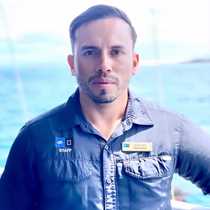Fernandina and Isabela Island (Punta Espinoza & Punta Vicente Roca)
The National Geographic Endeavour navigated to the western side of the Enchanted Archipelago, through a small passage of water called Bolivar Canal, where most of the endemic marine species of the Galápagos are found. From our windows we could see a very barren landscape belonging to the recent lava fields of the youngest of the Galápagos Islands known as Fernandina. We took our zodiacs to approach the moonscape island and had a dry landing at an area surrounded by mangroves.
This time the Galápagos took us back in time millions of years, with young lava flows covered with hundreds of the prehistoric-looking marine iguanas. Being reptiles, they are truly cold-blooded; therefore they needed to bask under the sun for many hours before they could go back in the ocean to forage on the green algae growing on the underwater lava rock. Some Sally Lightfoot crabs and ground finches were among the iguanas, feeding on the remains of molted skin that iguanas still had over their bodies.
Our path was a combination of white sand and pahoe-hoe lava, with all sorts of shells and coralline material; it was a very clear example of an uplifted peninsula that happened to rise above sea level in 1972. Here we encountered a couple of American Oystercatchers nesting and a small group of Galápagos flightless cormorants who were drying their vestigial wings. These flightless birds are one of the greatest examples of evolution by natural selection in the Galápagos and one the best cases of evolutionary trade-off; reducing the size of their wings but increasing massively the strength and thickness of their legs to make them perfect divers, able to dive up to 70 meters deep into the ocean, looking for food.
After the hike, we went on a snorkeling expedition where we saw many Galápagos horn sharks, penguins, rays, cormorants, and our younger explorers had a great time with sea lions playing and following us till the last second before we got out of the water. On our way back to the ship, above the tall white and red mangroves, a young Galápagos hawk was spotted patrolling the area and looking for prey, as he is the top predator on land in this archipelago.
Later in the day we navigated to the northern side of the Bolivar Canal, crossing the equator line for a third time now, but this time we had a celebration where we asked permission from King Neptune; surely our younger explorers were the ones delighted by this moment.
A zodiac ride was organized along the giant cliffs of Punta Vicente Roca, the snout of the Sea Horse Island (Isabela ), a place where the compacted ash cones and the pure basaltic lava meet together. On our ride we were more than lucky to spot several ocean sun fish (mola mola), and many Galápagos shearwaters. Shearwaters fly in large packs and this time they were following something big which was feeding underwater – something titanic and elegant at the same time – a large tropical whale with its calf, which breached many times, allowing us to enjoy the moment while the sun was going down and the sky turned all different colors.
I do have to mention do that while we finished watching the Galápagos penguins and many of the sea turtles, the sun illuminated one of the walls of the cliffs and covered it with a bright red color, decreasing its intensity more and more as the sun set…
All the words available are not enough to describe today, everything innocent and delightful of nature came together in one day, at one breathtaking unique place known as Galápagos.




